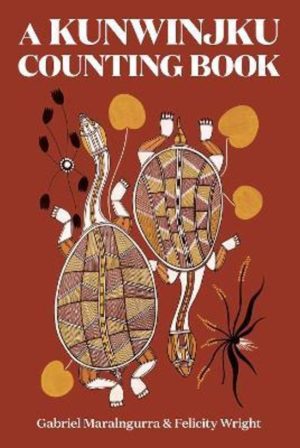Often counting books are designed for a very young audience. ‘A Kunwinjku Counting Book’ features language and content aimed at older young people and adults, with an opportunity to learn Kunwinjku words that describe each animal. The first edition was titled ‘The Kunwinjku Counting Book 123’ and published by Injalak Arts to sell at the Injalak Arts Centre and galleries In Darwin. The American publisher, Enchanted Lion Books, offers this new edition six years later. A distinctly different book, it appears in hardcover with dustjacket, textual changes, enhanced page and font design along with additional background information.
The traditional ochre, browns, white, black and acrylic feature here with intensified colours and bolder line. The cream paper, gold and black lettering capture attention for a rich viewing experience. Remove the dust jacket and deeply intense colours and patterns are attention-getters leading into the art-filled endpapers. Altogether these offer an art appreciation experience.
The introductory short text of five-six words for each of the 12 creatures living in West Arnhem Land offers a rhythmic read aloud while simultaneously commenting on each creature’s behaviour. For example, ‘Five agile wallabies eating leaves’ or ‘Eight water pythons slithering in the mud.’ Succinct information about each creature includes where they can be found, what they eat, and, if edible, what they taste like. Animals included are the crocodile, snake-necked turtles, water goannas, spoonbills, wallabies, echidnas, dragonflies, water pythons, snapping turtles, knob-tailed geckos, freshwater prawns and barramundi. Which groups of people are allowed to eat a particular animal, based on their cultural beliefs, is included.
Informative back pages include an explanation of ancient rock art common to the Bininj people. Tools and techniques used in Bininj art and how these feature today in the rarrk ‘x-ray style’ (the depiction of animals’ insides) are explained in words and images. A guide to pronunciation is included along with an illustrated page about the six seasons in Kunwinjku. Gabriel Maralngurra, the artist, features in a biographical profile and interview.
Much more than a counting book, this book is a work of art, a tribute to the Indigenous people of Australia, and a fascinating guide to Northern Territory ecology. Gabriel Maralngurra is an Aboriginal Australian artist from the Ngalngbali clan in Australia’s West Arnhem Land.

